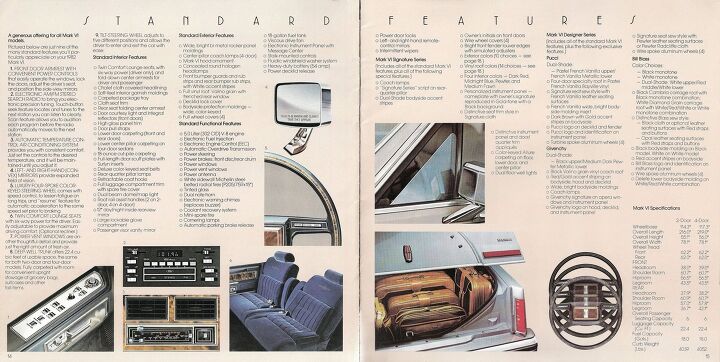Rare Rides Icons: The Lincoln Mark Series Cars, Feeling Continental (Part XXXIV)

In today’s Lincoln Mark coverage, we reach the conclusion of the ill-fated and unpopular Mark VI. Though the Mark of 1980 to 1983 was arguably the least interesting entry in the model’s history and the one with the least amount of effort put into it, Lincoln still charged a pretty penny for its PLC. But the market was changing, and so was Lincoln’s lineup.
It was a case of old nameplates fading away and then rising like the phoenix as something else. Concurrently, an unsuccessful model received the ax. Though the Mark VI was offered for just four model years, the rest of the Lincoln lineup was replaced entirely during its tenure.
The 1980-only Continental gave up its name in 1981 and became Town Car (the Town Coupe name vanished). 1980 was also the last year for the Granada-based midsize Versailles, a cynical product in every regard that was missed by few. Lincoln planners left some space for the Continental name to slumber in 1981. As the Panther Town Car took up its final identity, a new midsize Lincoln approached.
It was of course the Continental. In 1982 Continental returned, a divisively-styled new Fox platform bustle back sedan that offered a V6 engine. Lincoln followed Cadillac’s lead, as GM started the (short-lived) bustle-back trend three years prior in the 1979 Seville. In a first-ever (and perhaps an indication of fading prominence for the Mark), a Designer Series trim migrated outside the Mark: Givenchy appeared on the new Continental.
Cartier expanded its reach that same year and was available on the Town Car. These moves reduced the Designer Series availability on the flailing Mark VI, but Lincoln attempted to make up the difference by offering a four-door Designer Series Mark VI.
In 1983, Continental received a Givenchy trim once more, and there was also a new Valentino. This democratization of Designer had repercussions on the Mark VI, which lost the exclusive hold it had on the trims since their inception in 1976. Outside those changes, very little happened under the skin of the Mark VI. Aside from a different (EEC2) engine management system in 1982 and 1983 and some revisions of horsepower figures accordingly, trim changes were the primary focus of the Mark’s development team.
Available across all four years was a bevy of then-advanced equipment, in an attempt to give the Mark VI a prestige advantage over the Continental and Town Car and justify the high pricing the Mark carried. Most important among the features was a keyless entry system with Ford’s new keypad, offered as standard. Digital instruments were also fitted as standard but could be deleted for analog gauges from the Town Car.
Ford’s Auto Lamp (Twilight Sentinel in GM speak) meant headlights came on automatically at dusk, and the interior remained illuminated for a time after the ignition key was removed. On the topic of lights, we need to talk about Touring Lamps. They were a feature exclusive to the Mark VI and thank goodness for that.
Avoided by the majority of customers, Touring Lamps were a set of large, circular driving lamps affixed to the outside of the headlamp doors on two- and four-door Mark VIs. Activated only when the headlamp switch was set to the parking lamp position, they provided almost no useful light. Recall that the Mark VI had functional parking lamps in its corner lenses already.
Reinforcing the Touring Lamp’s limited purpose, they were hidden away immediately when Auto Lamp turned on the headlights and opened the doors. It’s unclear if the Touring Lamp was supposed to recall some grand lighting element from a Thirties luxury car, but buyers weren’t interested in it. Have a look at the headline image, and we can move on.
To pricing! Given the Mark VI’s unloved nature, it’s not as easy to find specific pricing information by trim and year, so we’ll be generalizing a bit today. The basic Mark VI of 1980 started at a steep $20,445 ($79,057 adj.) with no options or designer accouterments.
Designer Series cars cost around $22,500 ($87,003 adj.). While that was a notable increase, those editions arrived with more standard equipment and the illustrious-ish designer names. Finally, the Signature Series existed as a spiritual Collector’s Edition successor and asked top dollar for its real wood trim and large script badges: $24,750, a shocking $95,704 adjusted for inflation.
What did buyers think of the downsized yet still baroque and expensive Mark VI coupe and sedan? They were simply not impressed. Keep in mind Mark V sales figures, as the most successful version in the model’s history. It sold 80,321 its debut year, followed by 72,602 in 1978, and 75,939 in 1979 as buyers snapped up the last of the pre-downsized barges.
The Mark VI couldn’t manage half of the Mark V’s 228,862 sales, even though it had four model years to do so. Debut sales for 1980 were a high point as expected, but only reached 38,391 examples. Sales fell in 1981 to 36,398, before they dropped off a cliff in 1982: 26,336 sales. There was a slight rebound in 1983, but only to 30,856. Grand total: 131,981 Mark VIs, inclusive of coupe and sedan.
As commenters rightly outlined in our last entry, the foundational customer (Baby Boomers, born 1946-1964) of the PLC had changed by 1980. Those who started out in the aspirational Monte Carlo, Riviera, or Thunderbird in the late Sixties and early Seventies as young adults had outgrown a coupe by the dawn of the Eighties. Families with children, pets, and luggage didn’t jive so well with the two-door leather-lined coupe. However, that Jeep Wagoneer at the AMC dealership was mighty tempting.
Further, in an era of downsizing, fuel economy concerns, Japanese imports, and the approach of front-wheel drive, the PLC was a bit of a dinosaur. None of the successful baroque 70s PLCs made it through to the mid-Eighties intact, all passed away or donned a new identity. Disco was dead, and so was its car.
Thus it was time for a new aerodynamic age of coupe, as the domestic automakers attempted to modernize and resuscitate the PLC to keep the cash flowing. In Ford’s case, there would be a reunification of Thunderbird and Mark (and Cougar too) after a bitter separation period from 1977 to 1983. It was time for a luxurious Fox platform coupe that would affectionately be called the Aerobird. Mark VII is next time.
[Images: Ford]
Become a TTAC insider. Get the latest news, features, TTAC takes, and everything else that gets to the truth about cars first by subscribing to our newsletter.

Interested in lots of cars and their various historical contexts. Started writing articles for TTAC in late 2016, when my first posts were QOTDs. From there I started a few new series like Rare Rides, Buy/Drive/Burn, Abandoned History, and most recently Rare Rides Icons. Operating from a home base in Cincinnati, Ohio, a relative auto journalist dead zone. Many of my articles are prompted by something I'll see on social media that sparks my interest and causes me to research. Finding articles and information from the early days of the internet and beyond that covers the little details lost to time: trim packages, color and wheel choices, interior fabrics. Beyond those, I'm fascinated by automotive industry experiments, both failures and successes. Lately I've taken an interest in AI, and generating "what if" type images for car models long dead. Reincarnating a modern Toyota Paseo, Lincoln Mark IX, or Isuzu Trooper through a text prompt is fun. Fun to post them on Twitter too, and watch people overreact. To that end, the social media I use most is Twitter, @CoreyLewis86. I also contribute pieces for Forbes Wheels and Forbes Home.
More by Corey Lewis
Latest Car Reviews
Read moreLatest Product Reviews
Read moreRecent Comments
- AMcA My theory is that that when the Big 3 gave away the store to the UAW in the last contract, there was a side deal in which the UAW promised to go after the non-organized transplant plants. Even the UAW understands that if the wage differential gets too high it's gonna kill the golden goose.
- MKizzy Why else does range matter? Because in the EV advocate's dream scenario of a post-ICE future, the average multi-car household will find itself with more EVs in their garages and driveways than places to plug them in or the capacity to charge then all at once without significant electrical upgrades. Unless each vehicle has enough range to allow for multiple days without plugging in, fighting over charging access in multi-EV households will be right up there with finances for causes of domestic strife.
- 28-Cars-Later WSJ blurb in Think or Swim:Workers at Volkswagen's Tennessee factory voted to join the United Auto Workers, marking a historic win for the 89- year-old union that is seeking to expand where it has struggled before, with foreign-owned factories in the South.The vote is a breakthrough for the UAW, whose membership has shrunk by about three-quarters since the 1970s, to less than 400,000 workers last year.UAW leaders have hitched their growth ambitions to organizing nonunion auto factories, many of which are in southern states where the Detroit-based labor group has failed several times and antiunion sentiment abounds."People are ready for change," said Kelcey Smith, 48, who has worked in the VW plant's paint shop for about a year, after leaving his job at an Amazon.com warehouse in town. "We look forward to making history and bringing change throughout the entire South." ...Start the clock on a Chattanooga shutdown.
- 1995 SC Didn't Chrysler actually offer something with a rearward facing seat and a desk with a typewriter back in the 60s?
- The Oracle Happy Trails Tadge









































Comments
Join the conversation
A lot of people back then didn't like the downsizing idea, which is why some didn't sell better than before. Which is why in final gen sales were record high in sales. My own father wouldn't buy a downsized GM car, he switched to a Ford LTD, a nice car but he hated it but wanted a big car
Minor quibble. The down-sized full-sized 1980-only Continental (which was available with Town Car and Town Coupe trims) gave up its name in 1981 and became the Town Car. The name "Town Coupe" was never used after the 1980 model year. The 1981 Lincoln Town Car was available with a 2-door body style, but the 2-door Lincoln Town Car was discontinued and not offered for the 1982 model year and never returned to the Lincoln lineup.